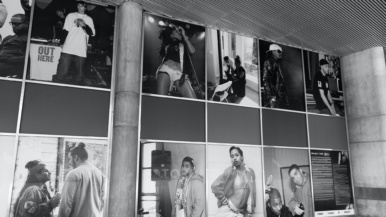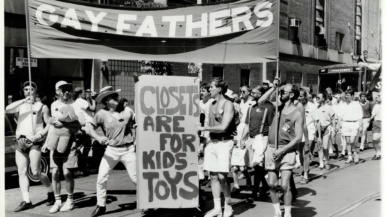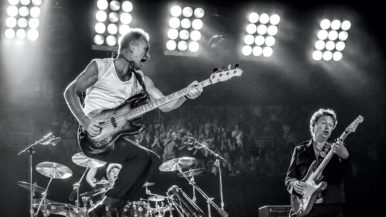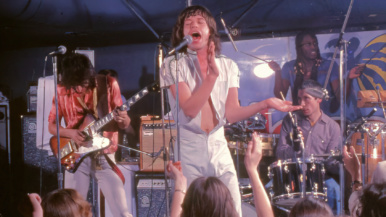Twelve photos that capture the drama and devotion of Toronto’s Good Friday processions over the years
Nearly every Easter weekend since 1969, Toronto photographer Vincenzo Pietropaolo has trained his lens on Little Italy’s Good Friday procession. Recently, he collected his favourites in a book called Ritual, a whopping series of 150 photos that captures the quirks and drama of the largest Catholic procession in North America (hundreds attend every year), and documents the way both the neighbourhood and the crowds have changed over the decades. Here, Pietropaolo talks about his most striking snaps.

College and Beatrice Streets, 1969
“This is the earliest photo in the book. You can see the people in their Sunday best: men in white shirts and ties, ladies with their heads covered and black purses. The procession was really small back then. The woman in the black mantle is playing Mary—Our Lady of Sorrows, or addolorata—mourning that Christ has just died. She’s following the lead car, an old Impala, which probably held a priest who would be reciting prayers over a loudspeaker. Since this procession is really a funeral march, bands would play dirges to accompany the procession. The mood would have been very sombre.”

Grace Street, 1971
“This is a very cinematic shot. You have people with their heads bowed down in reverence, and the dead body of Jesus resting on a platform called a bier. Behind that, you can see the flag of the Vatican, as well as the Canadian and Italian flags. There was one more statue, that of the addolorata, and that was the extent of the procession in those days—just two statues and people following behind with a band that played songs with titles like ‘Bitter Sadness.'”

College and Beatrice Streets, 1980
“The streetcars used to be a beautiful cream and rusty red, which was unique to Toronto. This car was moving eastbound, and there’s one right next to it trying to go westbound. In those days, they only closed the south side of the street—it was odd that they wouldn’t close the whole street, because it could be quite dangerous. As the procession got bigger and bigger over the years, the city had no choice but to close College and Grace completely. The procession goes on even when it rains. The scene playing out next to the streetcar doors is called the Encounter, where Jesus is being condemned by a Roman soldier. Over the years, they kept adding statues to the processions. In the ’90s, they added live representations as well.”

Manning Avenue, 1983
“In the 1980s, I started experimenting with colour film, and this shot is one of my favourites. The writing on the back of the tuba player’s score is actually in Portuguese. I love this picture because you see a picture of Jesus instead of the man’s face—the big, broad, worker’s hands contrasting with his fancy watch and ring is all a part of being in the procession and wearing your best.”

Grace Street, 1984
“You don’t really see this anymore, but as the saints go by, you’re supposed to fall to your knees in reverence. The most devout people do that, even if they’re old or wearing a fur coat. The woman in the forefront doesn’t have her head covered, but the older woman does. You can already see a generational difference there, even though they just seem about 10 years apart in age.”

Grace Street, 1997
“This is my favourite from the ’90s. Over time, Toronto’s procession became famous the world over, and people would travel to see it. A team from Italy decided to participate in 1998, and they brought their own saint, an 18th-century baroque sculpture on loan for a single year from a town called Recco, near Genoa. They had to get special permission from the Italian government and the Vatican because it’s a national heritage piece. There is an intimacy between the sculpture and the people holding it; it’s almost sensuous.”

Bellwoods Avenue, 1993
“Giuseppe Rauti has been portraying Jesus for 50 years. He’s in his late 70s. In the beginning, he’d just walk along with his cross, looking down, but now he prepares himself spiritually. He fasts three days in advance and takes a vow of silence for a whole week. It’s a joy that the community has let him do this for all these years—Jesus died when he was 33, so really, as someone in his 70s, this is the oldest Jesus anywhere. He just says that as long as the community wants him and God gives him the strength for it, he’ll reprise the role every year. He carries that huge cross by himself, barefoot. He’s an actor, of course, but he truly, truly believes in what he does.”

College Street, 2000
“During the procession, I saw someone watching out of their apartment window, so I asked, ‘Can I come up for a picture?’ Even in the pouring rain, the addolorata was walking on, her long mantle being carried by young girls.”

College Street, 2005
“Fabio Gesufatto has been doing this for 15 years, I believe. H portrays a different kind of Jesus, one that’s been pilloried and whipped by Roman soldiers after he’s condemned. These soldiers really take this seriously. I especially like this photo because of the guy reporting live in the forefront, as if it was a real event. That juxtaposition of the television reporter with the theatrics is cool. At this point, the procession had become a long piece of street theatre with at least three bands. Many people never see the whole thing, because that would mean standing still in a corner for hours. It’s ironic, because if you’re actually seeing the whole procession, you’re not taking part in it, which was originally the whole point.”


Grace Street, 1999 and 2015
“I photographed this man when he was a small boy and again as adult, with a picture of his late grandfather, who had died the previous year. He’s taking his grandfather’s place in the procession, so there’s a sense of continuity. He’s wearing a form of robe that the Apostles in the procession always wear.”

St. Francis of Assisi Church, 2013
“At the end of the procession, the statue of Jesus is brought inside the church. The most important moment is to kiss the statue and to pray for a moment—you can’t go home before doing that. That usually takes at least an hour, for everyone to stream in and out. This woman seems to be of profound faith, and she saw me with my camera. I nodded at her as if to ask if I may take her photo, and, probably recognizing me from over the years, she just smiled at me.”

Mansfield Avenue, 2015
“Now the procession has a new dimension. The essence of the core group of people is the same, but it’s also become a form of entertainment.”





